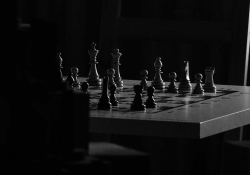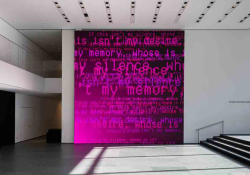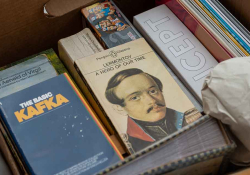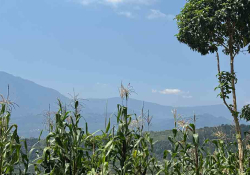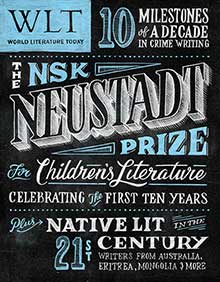The Nameless Saints
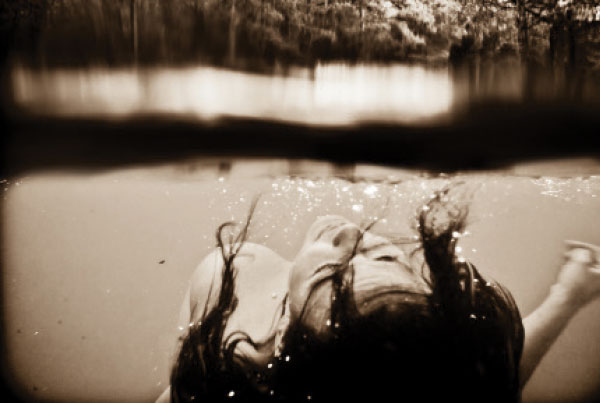
Andrés Felipe Solano tackles fiction in his novels and facts in his journalism—as a writer, he alternates between the real and the imaginary. Of course, that doesn’t mean the two are unrelated. In “The Nameless Saints,” he reports from the Colombian city of Puerto Berrío on an issue that occupies the space between reality and imagination: the practice of adopting corpses found floating down the Magdalena River as personal protectors. Solano explores the juncture between Colombia’s grim reality of violence and the hopeful fantasies of those who claim the dead.
When Antonio Cadavid met her, she had long hair, she was naked, and she was dead. The Magdalena River brought her three years ago, tangled up in the branches and the rubbish that the current drags along. She came floating down from some town up the river. Did they throw her into the water in Puerto Triunfo or in Puerto Nare? No one would ever know. During the days she spent in the morgue of Puerto Berrío, nobody asked about the twenty-five-year-old woman who died from a gunshot to the forehead. It was then that Cadavid chose her and gave her a name. He called her Sonia.
A fisherman found her in some bend of the largest graveyard in Colombia: the Magdalena River. In the town they said she was a guerilla, which they said about all the cadavers that slid down the river searching for the sea while the buzzards tore at their skin and guts. But Sonia came down intact and beautiful. That’s how she looked to Moca-Moca, the nickname by which everyone knows the stuttering housepainter, with burnished skin and albino eyes, rendered groggy by thirty-six years of inclement sun.
“She was a very pretty girl.”
Moca-Moca grins and indicates Sonia’s spot in the pavilion of the NN—those with ningún nombre, or “no name”—in the cemetery of Puerto Berrío. It’s a charred and overgrown space where the pigeons nest in the free vaults and a couple of scrapped coffins rot on the tall grass.
In this uninhabited place, Moca-Moca spends an hour every afternoon talking to a woman whom he never saw alive but feels is his own. In the end, the dead belong to whoever cares for them. His visits have acclimatized him to the smell of cadaverine, which is intensified by the midday heat. On his knees, he recites some prayer, perhaps a combination of the Lord’s Prayer and a Hail Mary; maybe a tangled rosary. After that he scrubs clean the marble stone that he had installed out of gratitude for the favors he has received, and before saying good-bye he begs, with one hand on the grave, for her to reveal the lottery numbers again. A few months ago Sonia whispered the winning figure into his ear, and Moca-Moca paid off his debts with the two million pesos that he collected. If left unsettled, they would have gotten him killed and thrown into the Magdalena, that river which—more than a river—is the red sea of Colombia.
There are no mass graves in these parts. All the victims of shootings and knifings go into the river, which carries them forever. This is all verified by Ramón Isaza, the oldest paramilitary leader in the region, who during his trial in 2007 claimed to have Alzheimer’s when they asked him for an account of his crimes. If the murderer doesn’t know where his victim rots, he doesn’t have so much trouble sleeping. What name would they have given to Antonio Cadavid if they had found him with a swollen belly in the next port? Ramiro, Libardo? Would some woman have taken care of his grave and his new baptism? With leaves stuck to his clothes and ears full of sand, would he have struck them as a handsome cadaver? The strange rules of this practice are very precise. A man can only choose a woman, and a woman a man. It’s a little marriage between living and dead, a bond to protect and accompany each other here and further beyond.
In the streams of the Magdalena the NN are saints, fought over by the campesinos. The locals drag them from the murky darkness of anonymous death, and the deceased reward them with health, love, or money. The living choose them and baptize them so that, in exchange for prayers and care, the dead might grant a high-earning husband for their daughters, a Honda motorcycle so their grandsons can join the swarm of moto-taxis that drive through the towns, a number they might bet on to win some extra money and paint the kitchen walls, which have been chipped for years. A life where the old river wouldn’t reek of sewage and they wouldn’t have to turn to the cemetery in search of dead strangers to solve their problems.
Sonia is not alone. She’s one of more than fifty unclaimed men and women whom the town of Puerto Berrío has buried on the right side of the churchyard, behind the military mausoleum, where a lady ensures that a statue of the Angel of Silence is set up on the first day of November every year. The statue, which watches over the place, stretches out on All Souls’ Day and descends toward the grave of Dr. Jimenez’s son. A few years ago the young man, a law student who dared to court a woman who one of the señores also fancied, was dragged from his house at eleven at night and returned at four in the morning in a sack, without testicles. Or was he raped and carved into pieces? Or did he die of a single bullet wound? Nobody agrees about the murder. A lemon seller who pushes his merchandise behind the main church of Puerto Berrío and who has his own NN—upon telling me, he remembers that it has been a few days since he changed the glass of water he leaves to quench her thirst—swears that they gave him a coup de grâce. Another woman, a shopper whose darling corpse whispered the number with which she won ten million pesos and finally built her house, opts for the bloodier version. As in so many other towns of the Magdalena Medio, the people make their conversations about the dead—in this case, those whom Arnulfo Aurán Vélez has buried.
•
The town gravedigger is charged with announcing the arrival of an NN to those who still lack their own. Last year only two people got lucky, but this year, which is only a couple of months old, three people have already received someone to protect them from wickedness and danger. The last nameless body appeared at the end of January in an empty field near the barrio called La Malena.
“People make more preparations for these ones than for the ones who have names,” says Durán, fanning himself with his wide-brimmed hat.
One of the new functions of this man, who is bearded and looks more like a horse-breaker than a gravedigger, is to make sure that nobody paints or writes anything on the graves of the new NN. Before the district attorney gave him this order to ensure that the dates of death and the sexes of the victims wouldn’t get mixed up, people used to decorate the vaults with drawings, plastic flowers, Christmas ornaments, or chips of marble with inscriptions like “May God forgive you.” And, of course, they wrote the names of the dead. There are Milagros and her still-red rose, Jesús and his salmon-colored stone, and Nena Cadavid, the other NN of Moca-Moca, who providently diversified in search of favors. Also present are Narciso Nanclares, Nevardo Nevado, and Nayro Núñez, bodies that nobody said good-bye to at La Última Lágrima, the stall at the outskirts of the cemetery where the bereaved drop off the coffin, have the deceased’s favorite songs played for two hundred pesos, and drink a double aguardiente for his eternal rest.
In Puerto Berrío, once the bastion of the left in the department of Antioquia and later one of the enclaves where the feared far-right group called M.A.S. took power, a veritable household industry fed by death has developed, incorporating La Última Lágrima—a dark chain of production that Gilberto Córdoba has refused to accept. His job came before all the massacres. He is simply a town carpenter who, as well as making furniture, learned how to make coffins and to dance salsa.
Zapatos Blancos (“White Shoes”), known for the footwear he used on nights out, back when the town was an important port, sits shirtless and polishes a coffin for which he’ll eventually charge ninety dollars. He has an hour of light left to finish cleaning up the wood. His shop closes at six, and he goes to sleep doped by the vapors of paint thinner and varnish. Córdoba has hair like a dandelion: white and untidy. During the eighties and nineties, when it rained dead bodies, this seventy-seven-year-old man busied himself with the few that perished by natural causes. The others, which were the vast majority, he left to the major undertakers, who did “express” burials and offered extravagant coffins and disproportionate metal Christs.
“I show this clipping to the people who ask me for strange things.”
On one of the walls of his 400-square-foot house-workshop, there is a framed piece of newspaper with a photo of the funeral of Pope Paul VI. The shot shows the procession carrying an austere coffin made of walnut.
“You see? If this is how they bury the popes, why would people want any other sort of coffin? Eh?”
In those simple coffins, the town buries the NN.
•
At midday a potent stench emanates from the drains of Puerto Berrío. It’s the vapor of the river that mixes with the sewer water and the waste of the restaurants on the quay, where the soldiers go in search of beer and prostitutes on their nights off. Twenty-five years ago the army’s Fourteenth Brigade set up shop in the former Hotel Magdalena, once the most important in the country. Seventy years before, the town was just as important as any departmental capital. In Remolino Grande, as it was baptized by the German expeditionary Alexander von Humboldt during his visit in 1801, the first building of Coltejer—Colombia’s flagship textile plant—went up. The structure had ducts to circulate the air and keep the building cool, an extraordinary design at the time. The powerful railroad also entered the area through Puerto Berrío, and in the rooms of the Hotel Magdalena the wedding parties were livened up by the era’s famous singers: the Argentine Libertad Lamarque, the Ecuadoran Olimpo Cárdenas, and the Mexican María Luisa Landín. The newlyweds departed to the coast in hydroplanes flown by German pilots. Politicians like Enrique Olaya Herrera announced their candidacy for the presidency by the side of the swimming pool. Puerto Berrío was an obligatory stop for the steamboats until the monumental bridge across the Magdalena River was built in 1963, and in barely twenty years the fireworks of December were replaced by revolver rounds, and the scarce ice needed to preserve the fish began to sell for the price of gold.
The Fourteenth Brigade inaugurated a monument to its fallen heroes near the bullring of the hotel, which also had a steam launderette, a travel agency, a zoo, and its own aqueduct. The metal statues are accompanied by four obligatory marble plaques. On the first three are the names of the soldiers, subofficers, and officers who lost their lives in combat. The fourth is blank. It waits for the name of the next dead body.
Of course, the best place to see the Magdalena River is the main balcony of the old hotel. From there, you can feel its immensity. For a century, steamboats like the Quindío, the Victoria, and the Stephenson Clarke rose and fell on its heavy waters. Big cats and caimans loitered around its shores. From the height of the town of Honda, people pulled out enough fish to feed themselves for a week simply by sticking their hands in the river. Today the Magdalena is as dead as the bodies it carries.
Some corpses have the good fortune to be rescued by men like Moca-Moca, who chose Sonia, baptized her, and finally made her his personal saint, his protector. In this simple ritual of “I choose you and give you a name,” the town painter almost erased the beastly death that was carried out upriver on the loveliest guerilla ever seen.
Translation from the Spanish
By Arthur Dixon

